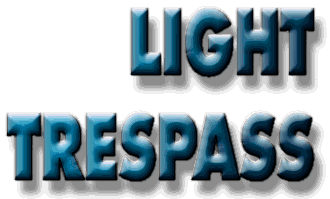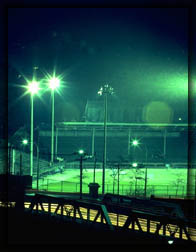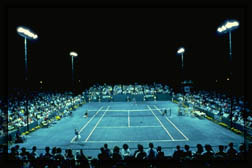


Canadians have been lighting outdoor sports fields for nighttime use since early in the twentieth century. General purpose incandescent floodlights were mounted on wooden poles and aimed at the playing surface to extend the use of outdoor sports facilities into the evening hours. Many of these facilities were located literally in fields on the outskirts of urban areas where stray light was never an issue.
As the nighttime use of outdoor facilities became more popular, especially with the growth of amateur sports, it became necessary to develop standards by which the illumination of these facilities could designed. One of the earliest guides was developed and published by the Illumination engineering Society in 1960 and entitled "Current Recommended Practice for Sports Lighting". the IES RP-6 published in 1960 provided the designer not only with a guide to illumination levels for various sports activities, but also with techniques to be used to reduce glare and spill light. In 1968, and again in 1988, RP-6 was republished and updated to include additional sports activities.
The contents of RP-6 (1968) provided recommendations for illumination levels for various outdoor sports. It addressed the subject of glare control by recommending locations and heights of lighting poles as well as luminaries beam spreads. All of this was intended to ensure that luminaries were removed from the direct line of site of players and spectators. Brief mention was made of the use of external glare shields and/or internal louvers to reduce excessive spill light which could cause a problem for spectators or adjacent properties. In this context, no recommendation was made as to the level of objectionable spill which could be tolerated. Presumably the intent was to avoid complaints or offer a means to correct an offending installation by shielding the source. In 1988, the problem of spill light was again addressed, but no specific recommendations were made. Shielding with internal and external louvers was mentioned as a possible fix along with a further caution about maintaining minimum mounting heights.
Unfortunately, this is a bandaid solution which has limited success in achieving the stated effect i.e.. reducing glare and spill light. The real problem stems from the industry's continuing use of spun aluminum symmetrical reflectors for their optical systems. circular or oblong patterns of light do not lend themselves to lighting rectangular areas efficiently and with adequate control. Because of the round symmetrical beam shapes, as much light is required to illuminate the area above the field for aerial sports; after all we play our sports in three dimensions. If sports lights are mounted at their proper height, we will project light into the area above the playing surface to illuminate fly balls etc., but we don't need light above the horizontal plane. In fact it is this light that becomes the subject of light trespass complaints.

So how do we provide quality lighting for outdoor sports activities without creating annoyance for our neighbours? Remember that our goal is to illuminate for the enjoyment of the players and spectators following the recommended practice provided by the Illuminating Engineering Society of North America and the various affiliated sports associations. Whatever else we do, we must provide the specified levels and uniformity of illumination required for the particular sports activity. The answer is to choose from the many new controlled optic floodlights and sportslights that are available on the market today and to use the judiciously. By following the design practices of the IESNA for mounting heights, levels of illumination and uniformity, then painting light into the playing area, annoying spill light and skyglow can be reduced significantly.
Let's look at a typical design procedure for lighting a softball field as an example. The steps would be as follows:
A) First of all you will need to know everything you can about the geometry of the field and the surrounding area. This would include the size of the infield (Usually a 60ft. baseline, plus a 20 ft. outer perimeter), plus an outfield radius which may be anywhere from 200 to 280 ft. Be sure that you are familiar with any restrictions (zonal or otherwise) to the height and locations of poles. Also identify the locations of any adjacent residential areas of other areas where stray light might be objectionable such as near observatories. Don't forget to include the locations of spectator stands and bleachers.
B) Secondly, determine the class of play. This is usually determined by the local league(s) which are expected to use the field for nighttime play. Make sure that you plan for the future; a well lit softball diamond may attract a more experienced league than that for which the field was originally designed.
C) At this point, you should refer to the IESNA RP-6 latest edition for the illumination levels, uniformity, mounting heights, and pole locations recommended for the geometry and class of play which you identified in A) and B).

Choose you light source. This would normally be metal halide for good colour quality, light output and overall efficiency, however; some local bylaws may require the use of high pressure sodium. Mercury vapour or incandescent are no longer recommended because of their inefficient use of energy.
E) Now comes the fun par. If you are using a consulting engineer or outside designer to develop your lighting design, make sure that you provide them with all the information discussed above. Be sure to emphasize that light trespass and skyglow are a particular concern. If you are the designer then this is your opportunity to be creative.
The initial steps in any lighting design would involve sketching out the playing area and the surrounding geographical features such as bleachers and adjacent buildings. Don't forget to include any residential areas etc. Using the IESNA recommendations you would locate the infield and outfield poles and establish minimum mounting heights for the fixtures.
The next step is extremely important. This is where you decide to use controlled optic sportslights instead of traditional round symmetrical floodlights. This decision having been made, you now have a wide variety of different beam patterns to choose from. These include not only the standard round beams in narrow, medium and wide patterns, but also vertical and horizontal rectangular patterns for lighting the areas close to the poles, and sharp cutoff asymmetrical patterns for lighting the long throw areas in centre field. by mixing and matching these optics you can literally paint the field with light, and avoid unnecessary complaints from the neighbours. Performing the design work is not as difficult as it may sound. With the latest computer design programs, you can add, delete, change fixture types, and re-aim fixtures quickly to see your results graphically as you make the changes.
With our increasingly hectic schedules and our need for physical activity in our leisure time, having the availability of well-lit sports facilities is a tremendous asset for sports field managers. A properly lit outdoor sports field can add significantly to the enjoyment of our leisure hours and relieve the tresses of our modern lifestyles. In designing these facilities, however; we must respect the needs and privacy of our neighbours in the communities in which these facilities are located. Careful selection of sports lighting equipment and attention to detail in designing the lighting system will go a long way to maintaining or improving community relations.
William A. Smelser is Brand Manager; HID Products for Cooper Lighting in Mississauga, Ontario Canada.